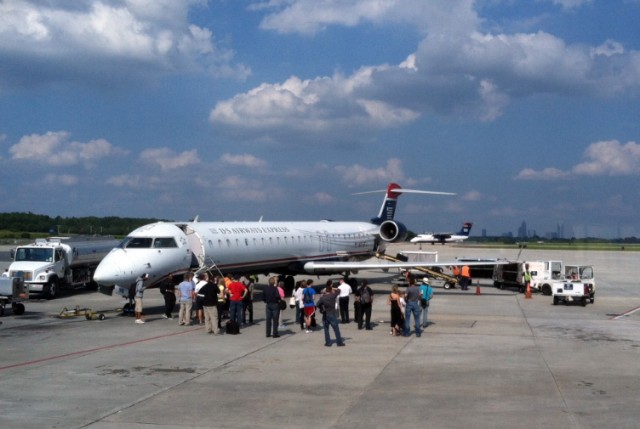
People picking up their bags. Photo by Andrew Vane.
This Story was Written by Andrew Vane for AirlineReporter.com:
Although not filled with the glory of a wide-body international flight typically experienced by others, any opportunity to fly commercially always brings a smile to my face. Getting to fly, no matter the distance or aircraft, is what being an #AvGeek is all about! To quote a childrens book titled ’œRailroad Toad’ by Susan Schade and John Buller (that I used to read to my children): ’œGive me a ticket to anywhere, the farther the better I don’t care!’
Well, that opportunity rolled around again for me. This time, I got to fly for business from my home city of Charlotte, North Carolina to the capital of Pennsylvania, Harrisburg. Up one afternoon and back the next is all I had time for with this trip.
To give you some background on Charlotte-Douglas International Airport (CLT), in 2012 it was the eighth-busiest airport in the US and had more domestic flights than New York’s LaGuardia and Kennedy combined. As a major hub to US Airways (soon to become American Airlines), the airport has grown from three small crisscrossing runways in the 1960’s to four long runways capable of handling an A340-600 or Boeing 777. CLT officials are also planning to give the longest runway a 2,000 foot extension at some point in the future. Hmmmm. My last fortune cookie said ’œI see big things in your future’ so perhaps someday an A380 will grace CLT.
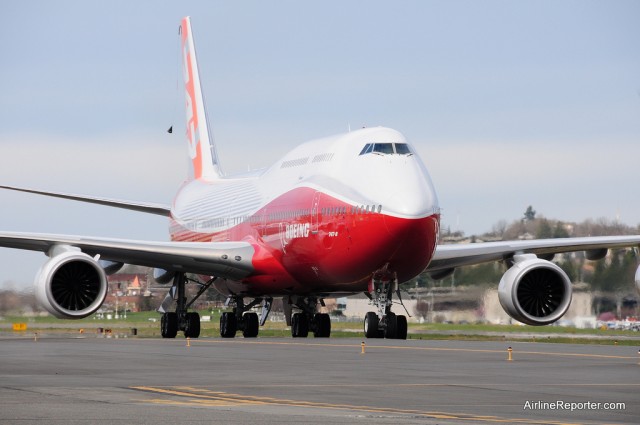
The first Boeing 747-8I. But how long will the model last?
There are few who can make a case against the Boeing 747 as the most majestic and beautiful airliner in the sky. I love the 747 (any variant) for its unique shape and instant recognition; you just won’t find folks lining up to tell you about the classic lines of the A380. Originally released in 1970, the Queen of the Skies has defined the term “jumbo jet” for multiple generations. But, despite the 747’s 40+ years as a long-haul mainstay for airlines around the world, is the future of the 747 and its latest variant, the 747-8, in jeopardy?
The Fiero Problem
The issue doesn’t seem to be that the 747 has gotten stale in its old age (in fact, Boeing’s latest version features new engines, a redesigned wing, a fuselage stretch, and advanced avionics; some might argue that Boeing spent WAY too much capital on a plane with so few orders). Rather, the problem seems to be that other planes have gotten so much better. This reminds me of that 80’s darling, the Pontiac Fiero, and its cool uncle, the Chevrolet Corvette.
GM and Pontiac built the Fiero from 1984-1988. A mid-engined, two-seater sports car with sharp (for the 80’s) looks, the Fiero did a lot of things well that the Corvette also was known for. Although not officially acknowledged by GM as a reason for ending the program, enthusiasts maintain that GM killed the Fiero because it was encroaching on the performance envelope of the ‘Vette, at lower acquisition and operating costs. Sound familiar? If you’ve ever flown on a Boeing 777, it should.
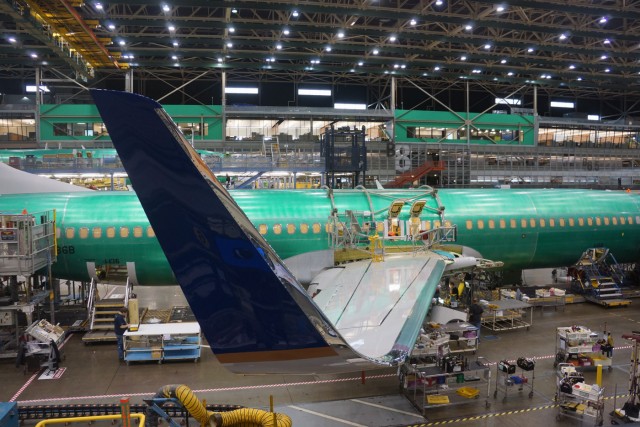
COPA Boeing 737 in the Renton Factory. Image by Chris Sloan.
This story was written by Chris Sloan and originally was published on Airchive.com. This is the next of a multi-part series talking about the Boeing 737 factory in Renton. Read the first part: A Historical Look at Boeing’s 737 Factory in Renton and second part: Inside Boeing’s 737 Renton Factory and the Successful Next Gen.
The Boeing 737 Goes Into ’œMAX’ Overdrive
The Boeing 737 NextGen order book continued to bulge, growing virtually unabated even through the deep worldwide economic slowdown / crisis of 2008-12. Ironically, this era of financial strife and sharply escalating fuel costs, as well as the growth of emerging markets, helped 737 and A320 sales go from strength to strength. Boeing however didn’t stand on it its laurels or did it?
Boeing claims with the introduction of its latest performance improvement package ’œPIP’, today’s NGs are 6-7 more efficient then when they were first introduced in the late 1990s. Boeing’s Tinseth points out that ’œThe (737) program has taken off with record sales. It’s simple. We make it better every time. We were first in its class with ETOPS 180, glass cockpits, Sky Interiors, and high bypass engines. We lower the operating costs through such new technologies as blended winglets, heads up display, carbon brakes, and more fuel-efficient engines. We enhance customer appeal with the new Sky Interior. This is an airplane that appeals to the heart of the market: emerging and developing economies and it is very successful with the LCC business model’. These new LCC airlines in emerging markets include Lion Air, Air Asia, and Gol! An unintended benefit of the weak economy, particularly in the U.S., is the poor financial results led to an elderly, fuel-in-efficient, maintenance intensive fleet which created an advantage and some say a bubble for airframe manufacturers, particularly in this sweet smart of the market. ’œThe significant driver in the US is the demand to replace older and less efficient aircraft’, said Tinseth.
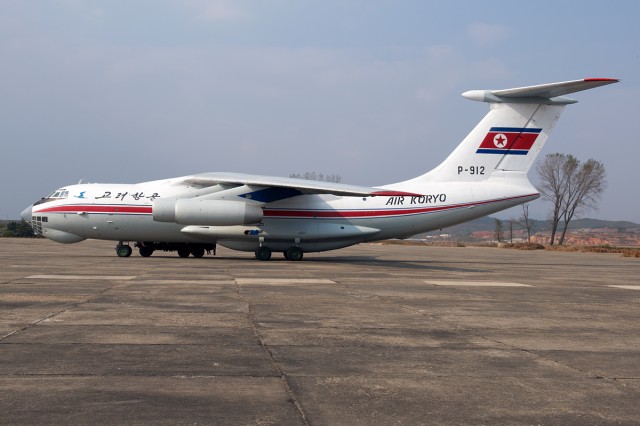
Air Koryo IL-76MD (P-912) sitting in North Korea.
After UPS stopped doing weekend passenger charters with specifically configured 727s, hitching a ride on a freighter became something most civilians could only dream of. Even then, their charter aircraft had windows, conventional seats, easily accessible lavatories, and galleys. Although a 727 is a unique aircraft to fly on these days, I prefer Russian metal.
Soviet-era freighters are iconic. Anyone who has ever seen an AN-124 (Ruslan) land at KPAE knows the kind of crowd they can draw. I didn’t get to travel on a Ruslan, but I did get to go on the most common Russian cargo aircraft: The IL-76MD.
P-912 was one of the last IL-76MDs ever made, despite still being equipped with the ubiquitous Soloviev D-30. Rolling off the line in 1990, this aircraft has been with Air Koryo ever since. Those of you who read my IL-18 article will remember my primary complaint: It was not loud enough. The IL-76 totally comes through.
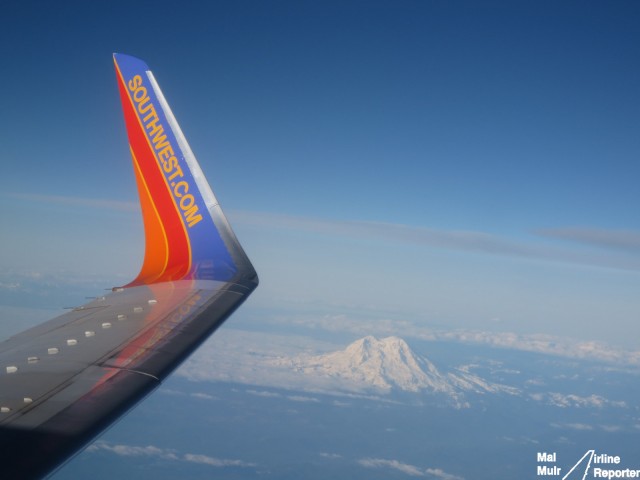
Passing Mt Rainier on-board a Southwest Airlines 737.
When I wanted to get between Seattle (SEA) and San Jose (SJC) via a direct flight, I didn’t have too many choices. I could have either flown on Alaska or Southwest Airlines. Since I had never flown Southwest before, I decided to give it a try and tick a new airline off my list.
The whole experience began the day before my flight when it was time to check in. I had read a few guides (although not the one written by the founder of this very website — oops) on how to deal with a Southwest flight.
Southwest, unlike any airline I had ever flown before, does not assign seating — it is a ’œFree for all’. Your ticket simply lists your boarding group (A, B or C) and a number which is your place in line. When you get on-board you are free to sit wherever you want.
The first 15 in the A group are reserved for Southwest’s frequent flyers or ’œA listers’. Some fare classes and those who pay for automatic early check-in [aka EarlyBird] snag the majority of the A group. The first 60 guests get the A group, the next 60 get B and whatever is leftover gets C. You obviously don’t want to be in the C group, if you don’t like middle seats. I luckily scored an A group ticket — game on.




